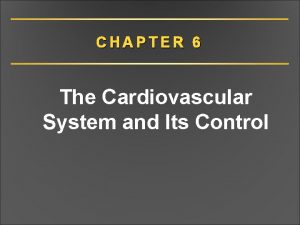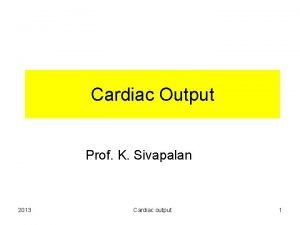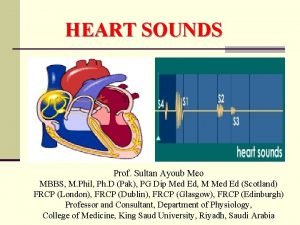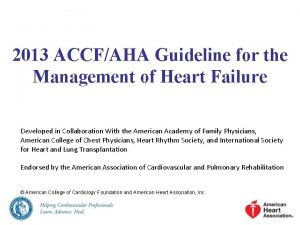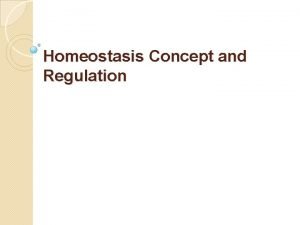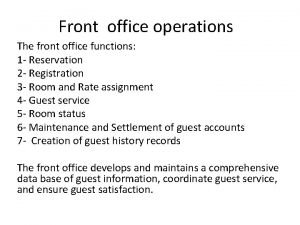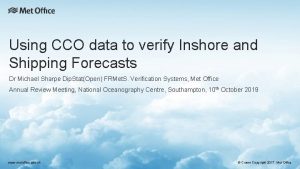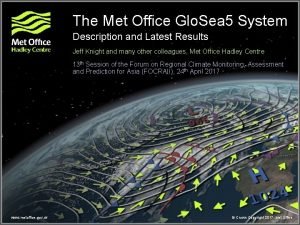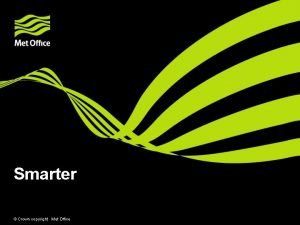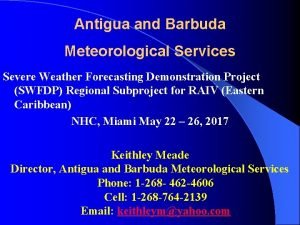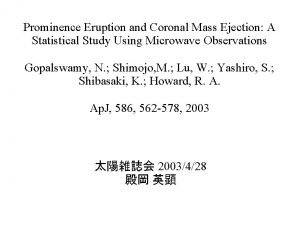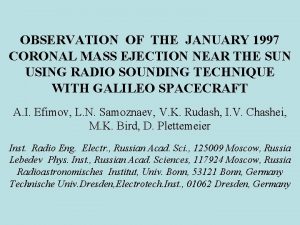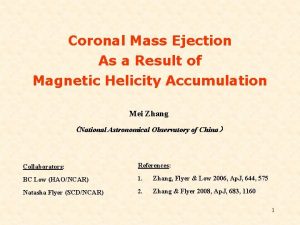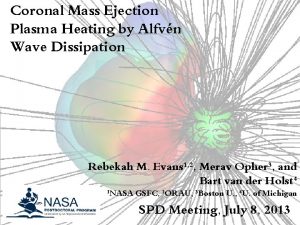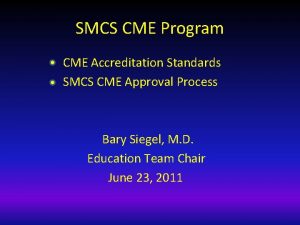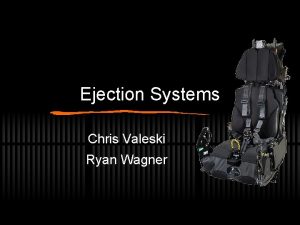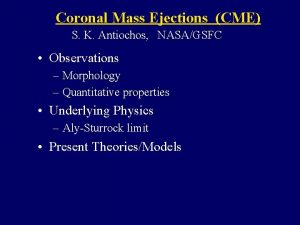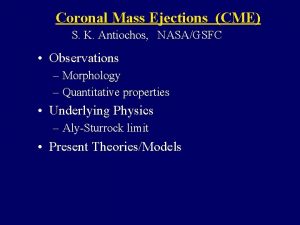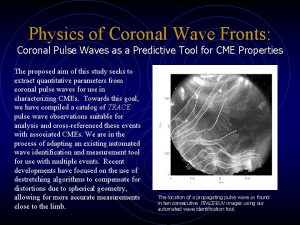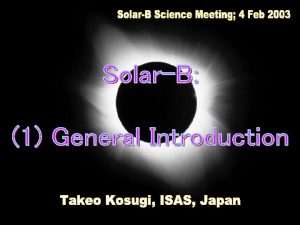The Met Office Operational Coronal Mass Ejection CME
















- Slides: 16

The Met Office Operational Coronal Mass Ejection (CME) Ensemble Forecasting System Siegfried Gonzi and David Jackson https: //www. metoffice. gov. uk/public/weather/space-weather/ Met Office, UK 2 – 6 Nov 2020 European Space Weather Symposium 2020 @Crown Copyright siegfried. gonzi@metoffice. gov. uk

Met Office Space Weather Forecasters analyse images using CME Analysis Tool (CAT) to identify CMEs • 24/7 Operations • Fully integrated within Met Office Operations Centre • National capability supporting government, military, and critical sectors • Team includes • Space Weather Operational Meteorologists • Scientists • Programme managers • IT developers Siegfried Gonzi ESWS 2020

Our Forecasters fit teardrop shape to observed CME from 2 angles CONE FILES: ncmes=3, ldates(1)='2017 -11 -29 T 04: 30' ldates(2)='2017 -11 -30 T 06: 48' ldates(3)='2017 -12 -01 T 07: 51' lat(1)=6. 0 lat(2)=28. 72 lat(3)=-7. 44 lon(1)=-92. 0 lon(2)=60. 54 lon(3)=129. 20 rmajor(1)=17. 0 rmajor(2)=19. 18 rmajor(3)=11. 35 vcld(1)=448. 0 vcld(2)=722. 62 vcld(3)=230. 56 -5º +5º -5º lon © Crown copyright Met Office STEREO-A STEREO-B (Solar Terrestrial Relations Observatory) +5º -15º +15º rmajor lat Siegfried Gonzi ESWS 2020 SOHO (Solar and Heliospheric Observatory) ± 20% vcld Coronograph 4 cone file Parameters are randomly perturbed within a pre-defined range: 3 e. g. lat = lat + random. uniform(-5, 5)

CAT Analysis used for 24 -Member Ensemble CME 5 day forecast Forecasts: Plasma Density • We run ENLIL (forward model) operationally every 2 hours in medium resolution (rxθxΦ) (512 x 60ºx 180º). • 24 -ensemble run in low resolution (256 x 30ºx 90º). 7 Sep 12 Sep Wind Speed Earth STEREO-A STEREO-B 24 -Member Ensemble Time Series of Solar Wind Speed at Earth 11 Sep 15 Sep 2017 Siegfried Gonzi ESWS 2020

Independent Study: Our CME Forecasting System has good performance 2013 -2017 Met Office CME Arrivals vs other Models But we also know our ensemble system is not perfect and has to be improved for our next generation Met Office CME forecasting system. Met Office SIDC SWPC Riley et al 2017 © Crown copyright Met Office 5 Siegfried Gonzi ESWS 2020

Automatic Detection of CME Arrival at Earth and Validation of 24 -Member Ensemble System NASA Observed Arrival Met Office Predicted Arrival Met Office Automatic Predicted Arrival (Min, Max) P ΔP ΔTime Brute force: finding all the inflection points where the 1 st derivative gradient jumps to a threshold (e. g. 0. 5 n. Pa/Day. Frac). Counting all the members that fall within NASA+-12 hours. For example if 12 member falls into the window the probability is 52% (12/23). • Also compare the control run and if ensemble would add value. Test if forecaster adds value on top of automatic CME detection. P [Pa] ~ D (p/cm 3) * V (m/s) Siegfried Gonzi ESWS 2020

Automatic CME Detection Algorithm cannot really beat Forecaster Operational 24 -ensemble Uncorrected GONG 48 -ensemble CME too slow NASA – Model CME too fast % 2017 Hits wrt NASA+-12 h Siegfried Gonzi ESWS 2029

Roadmap for our Next Generation CME Ensemble Forecasting System • • • Need to find a better way to perturb the parameters in the cone files. Currently we are testing a method where the 4 parameters xi are perturbed with combinations of: xi-dxi, xi+dxi. For 4 parameters this method requires 81 (34) ensemble members (e. g. Pizzo et al 2015). 8 Siegfried Gonzi ESWS 2020

But we also have to consider this • We are testing initializing ENLIL with ADAPT. This would free us from creating our own ensembles as ADAPT has 12 ensemble members as default. Current: 1 cone file leads to 24 additional initial CME conditions. We use the same GONG synoptic map and boundary conditions for all 24 ENLIL ensemble runs. 1 Solar wind speed, plasma density, etc. 24 1 With ADAPT we use the same cone file in ENLIL but every run receives different (GONG) boundary conditions. Solar wind speed, plasma density, etc. 12 Siegfried Gonzi ESWS 2020

Spare Slides for further Discussion 10 Siegfried Gonzi ESWS 2020

Computer Resources Demand fairly modest (in theory) • Every 2 hours 1 node (36 processors) ENLIL medium resolution: 50 minutes. • Every 2 hours 24 nodes (36 processors each) ENLIL low resolution: 5 -10 minutes. • Every 2 hours 12 nodes (36 processors each) ADAPT-ENLIL (medium) 50 minutes. Siegfried Gonzi ESWS 2020

CAT-HI • CME analysis tool (CAT) uses SOHO + STEREO c/graphs to estimate CME speed, location, width. • CAT-HI uses STEREO-HI in addition to c/graphs. • SOHO/LASCO: C 1 = 1 -3 Rs, C 2 = 1. 5 -6 Rs, C 3 = 3. 5 – 30 Rs • STEREO: COR 1 = 1. 5 -4 Rs, COR 2 = 1. 5 -15 Rs • STEREO H 1: 80 Rs • Po. C study - benefit in pruning ensembles rather than improved CME forecasts. Wharton et al. 2019 • Further work on CAT assumptions. © Crown copyright Met Office Shows also value of L 5 coronagraph and HI observations 12 Siegfried Gonzi ESWS 2020

To create a better Ensemble System we need to validate our existing one How should we validate/evaluate the ensemble system? Our forecasters analyse ensemble output; but is done based on experience and training of the forecaster. Forecasters add value to flare forecasting Can we build an automatic CME detection arrival time detection algorithm? And what is the added value of the forecaster? © Crown copyright Met Office Murray et al. 2016 13 Siegfried Gonzi ESWS 2020

Error of Ensemble Spread • Can the following been used to get to grips with the magnitude of the spread (Fortin et al 2014: Why Should Ensemble Spread Match the RMSE of the Ensemble Mean? ): 2017 Ens 24 oper Ens 48 ADAPT 12 Siegfried Gonzi ESWS 2020

Can Meteorological Data Assimilation (DA) Methods be used by Space Weather Applications? Siegfried Gonzi ESWS 2020

Heliospheric Data Assimilation OBS • Need data ahead of Earth to improve forecasts at Earth. • But need to run model back in time to update inner boundary – otherwise information gets swept out beyond 1 AU by solar wind. • Lang et al (2017) showed that En. KF can’t work with Enlil for this reason. • Applying 4 D-Var to 2 D solar wind model (Riley & Lionello) much more successful (Lang et al, 2018) since adjoint updates previous model state. RMSE in near-Earth solar wind speed Blue = prior state, from the MAS ensemble. Green = posterior state, from DA of STEREO A and B. • Window = 27 days. Simple linear model (NWP = 6 hrs). What about for an MHD model? May show value of L 5 in-situ (and, later, HI) obs Siegfried Gonzi ESWS 2020
 Factors affecting stroke volume
Factors affecting stroke volume Machinary murmur
Machinary murmur Ejection fraction vs stroke volume
Ejection fraction vs stroke volume Ejection fraction vs stroke volume
Ejection fraction vs stroke volume Left sternal border
Left sternal border Cardiomegay
Cardiomegay Systolic mumur
Systolic mumur Classification of ejection fraction
Classification of ejection fraction Milk ejection reflex flowchart
Milk ejection reflex flowchart Front office personnel
Front office personnel Met office inshore
Met office inshore Met office
Met office Glosea5 met office
Glosea5 met office Copyright
Copyright Ukv model
Ukv model Antigua met office
Antigua met office Weatherbonk
Weatherbonk


